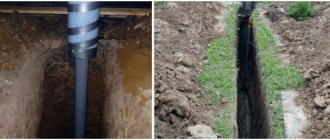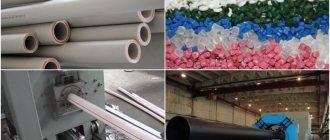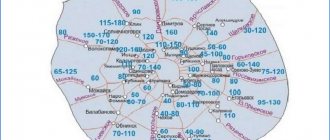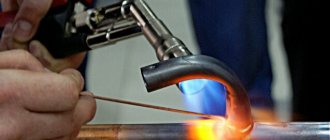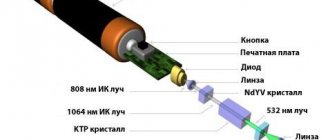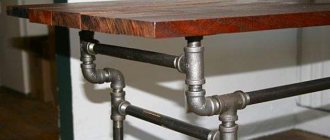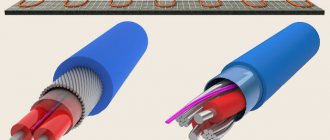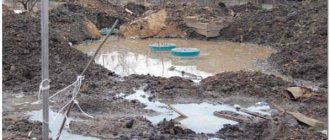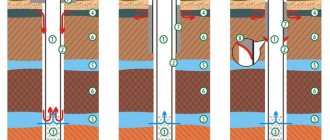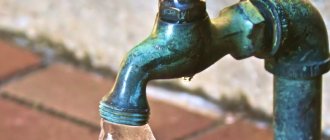Features of cross-linked polyethylene pipes
Cross-linked polyethylene is a material that is produced by polymerization of ethylene with additional cross-linking at the molecular level.
Cross-linked polyethylene exhibits special physical properties:
- Solidity. Polyethylene pipes do not crack when exposed to low temperatures.
- High degree of elasticity. The pipes are easily wound into coils and bend without breaking.
- Maintaining the original shape. If physical force is applied to a cross-linked polyethylene pipe and it is deformed (for example, stretched in diameter), then after the end of the impact the material will tend to return to its original shape.
- Retains shape when exposed to high temperatures. When transporting hot filler, the pipeline does not deform, provided that there is no simultaneous exposure to pressure.
- Chemical inertness. The cross-linked polyethylene pipeline remains chemically resistant to slightly acidic or alkaline environments and organic solvents. With prolonged exposure to fats, polyethylene pipes may swell somewhat. Cross-linked polyethylene does not absorb or emit harmful substances. Recommended for transporting drinking liquids and for use in the food industry.
- Environmental friendliness. The material does not contain heavy metals and halogens.
- Impact resistance at low temperatures (up to -50 degrees).
- The ability to dampen sound waves.
- Resistance of the material to water hammer during operation.
- Perfect smoothness of the surface of the inner wall. Salts or mechanical impurities are not deposited on polyethylene communications.
- Low weight per linear meter.
Communications made of cross-linked polyethylene can be operated in temperatures from +120 to -120 degrees without loss of tightness. Withstand short-term temperature surges up to 200 degrees and pressure up to 20 atm.
This is interesting! Tests show that pipes made of cross-linked polyethylene when operated in conditions of 90 degrees and a pressure of 9 atm. guaranteed to last 15 years. When the temperature drops to 70 degrees, their service life increases to 50 years.
What to choose
The answer to this question depends on the criteria that will be a priority for the owner:
- Based on the technical characteristics, we can conclude that for floor insulation in an apartment building it is better to use metal-plastic products - they are more resistant to operation under harsh conditions of pressure and temperature differences.
- When installing it yourself, it is also better to pay a little more for metal-plastic, but make the installation work easier for yourself.
- Cross-linked polyethylene will serve faithfully in an individual home. Even if you forget to drain the water and the system freezes, there will be no problem, the quality of the pipes will not suffer.
- A limited budget with professional skills will also allow you to choose more economical polyethylene.
We recommend that you read: What paint is suitable for painting heating radiators?
Both materials are guaranteed to last at least 50 years, withstand the average operating parameters of a heating system on a water circuit well, and do not differ critically in cost.
Types of cross-linked polyethylene pipes
According to their purpose, cross-linked polyethylene pipes are divided into:
- universal – they can be used for installation of heating systems and heated floors;
- specialized - products that are intended either for the installation of water heating or for the installation of a heated floor system.
We recommend that you familiarize yourself with: Sewer pipes, their types and installation rules
To install a water supply system, you can use any category of polyethylene pipes.
According to the method of stitching ethylene polymers, the pipe material is marked accordingly and is divided into:
- PEXa – peroxide firmware;
- PEXb – gas treatment;
- PEXc – electron bombardment;
- PEXd – chemical exposure to nitrogen compounds.
Market leaders in the production of high-quality cross-linked polyethylene pipe materials:
- RAUTITAN. Pipes of this brand are produced by a German concern. The consumer is offered 4 types of pipes in a size range from 12 to 250 mm.
- WIRSBO. Pipes from Finnish manufacturers who specialize in small and medium diameters from 12 to 150 mm.
- GOLAN. The Israeli brand offers the largest selection from 12 to 500 mm in diameter.
The cost of cross-linked polyethylene pipes from global manufacturers varies within close limits. Difference in price for fittings.
Note! The best result when installing communications is obtained when using pipes and fittings from the same manufacturer, since this guarantees the uniformity of the raw materials.
Evaluation criteria for pipe materials
I will list the main points of operating a water pipeline for floor heating. Taken into account:
- Heating temperature. It fluctuates in the range of 30...55 °C.
- Constant pressure in the circuit. It will be 1.5-2 bar; when testing the system, a pressure of 6 bar is used.
- The pipeline is most often located in a screed, where it is subjected to pressure from the pressure of water and concrete.
Thus, the most important parameters of pipes for heated floors:
- Operating temperature 30...55 °C.
- Pressure up to 6 bar.
- Sufficient thermal conductivity.
Protection against oxygen penetration into the channel, thermal expansion indicators, corrosion resistance, and ease of installation are also important.
Connection methods
There are several ways to connect parts of the pipeline during installation:
- compression (crimp) fittings;
- compression fittings;
- electric welded fittings.
The choice of a specific connection type depends on the planned operating characteristics.
To install communications, you may need the following tools:
- Special pipe cutter-scissors. A pipe cutter allows you to cut pipes into sections of the desired size without applying excessive effort. In this case, the cut will be smooth, without burrs, at an angle of 90 degrees. Such a cut will ensure high quality and reliability of the future joint.
- Hydraulic Press.
- Collet expander for increasing the diameter of the pipe before inserting the fitting.
- Pliers.
- Wrenches for tightening the crimp nut.
- Fitting.
When using electric welding fittings, you will need a special welding machine. It can be rented.
Connection with compression fittings
Installation of cross-linked polyethylene pipes using compression fittings is carried out on water supply lines. Here you will need a minimum of tools - just a pipe cutter and a wrench or adjustable wrench.
We recommend that you read: Hydrodynamic flushing of the sewerage system - cleaning pipes from various types of blockages
The work algorithm is as follows:
- The fitting is unscrewed and a ferrule nut and split ring are sequentially placed on the end of the pipe.
- The split ring is installed 1 mm from the edge of the cut.
- The fitting of the connecting piece is inserted into the pipe until it stops.
- Carefully screw the ferrule nut onto the fitting, trying to tighten it tightly, but not overtighten it.
Due to the plasticity of polyethylene, such a connection does not require additional sealing. It can be quickly disassembled if necessary.
Press fittings
The use of press fittings eliminates the disassembly of communications without damage. The connection is reliable, but not separable. For work you need a collet expander and a press fitting.
Connection installation procedure:
- A press ring (press sleeve) is put on the prepared section of pipe, moving it from the edge.
- An expander is inserted into the pipe and stretched to the size of the fitting.
- The expander is removed and the connecting piece is inserted in its place.
- Thanks to the molecular memory of the material, the pipe contracts and tightly grips the connecting fitting.
- Additional fixation is carried out by pulling the press ring onto the edge of the pipe and pressing it with a hand press.
In this connection there is no external pressure on the connection point. Quality and reliability are due to the special properties of cross-linked polyethylene itself.
Electric welding connection
Electric welding on polyethylene communications is carried out only using special fittings.
Work order:
- An electric welded coupling is placed on the prepared pipes.
- A welding machine is connected to the contacts on the fitting.
- Welding occurs when the material is heated to a temperature of 170 degrees.
- The heating time is set automatically, depending on the diameter of the pipeline. If the welding machine does not have such a function, then the welding time and temperature should be found in the documentation for the fitting.
- At the end of the welding process, the machine is turned off and the connection is allowed to cool.
This connection method is the most expensive, but also the most reliable. There are no restrictions on temperature and pressure for the operation of pipelines using electric welded fittings. The connection is stronger than the pipes themselves.
We recommend that you read: Compression fittings for installation of steel pipes
Performing the stitching process
The crosslinking process is aimed at eliminating one of the main disadvantages - thermoplasticity. The output is polyethylene, which remains flexible but does not deform at temperatures above 80 degrees.
Note! Due to the fact that the basis of the cross-linked polymer is pure carbon, when exposed to temperatures above 400 ºС, the material will begin to melt.
Technical parameters of the product depend on the chosen method of obtaining cross-linking:
- silane;
- peroxide;
- electron beam.
In the first method, a substitution reaction occurs using silane (a reagent). The second method is characterized by preliminary mixing of raw materials and inhibitor, and the crosslinking process is carried out under pressure. The third direction uses irradiation, under the influence of which the formation of additional bonds and substitution occurs.
Rules for working with cross-linked polyethylene
When laying a heated floor made of cross-linked polyethylene, it is important to firmly fix all bends with special clips on the dowels, since the material will try to return to its original state, especially at small bending angles. By following the rules for working with the material at the installation stage, you can avoid problems when using heated floors in the future:
- Due to the elasticity of the material, cross-linked polyethylene requires reliable fastening. The best installation for such pipes is special (there are even decorative) gutters. If single clips are used for fastening, they must be installed: on straight sections at least 1 meter apart, at joints, for rigid fixation of bends at a minimum of 3 points.
- When installing a heated floor on a cement screed, additional insulation for pipes is installed.
- When installing cold water supply communications, additional thermal insulation is required. This is necessary to prevent condensation from forming on the pipeline.
- The basis for high-quality installation is a smooth cut when preparing pipes. It is important that the cut is at an angle of 90 degrees to the guide axis. Burrs, waves, and uneven cuts will cause leaks in the future. To cut pipe material, it is not recommended to use a hacksaw - only a pipe cutter.
Note! For a one-time installation, you can purchase an inexpensive pipe cutter or rent a professional tool.
Metal-plastic
Polyethylene pipes with an aluminum layer are used less and less. They are also easy to install, robust, flexible, durable and affordable. The disadvantages of the material are the high price of fittings and low aesthetic properties. Most often, high-quality metal-plastic is used in the construction of heating systems.
Advantages
Plastic pipes do not have problems with corrosion - and this is their main advantage over, for example, steel pipes. If we compare it with stainless or copper pipes, which are also famous for their durability, then plastic ones are much more expensive.
The smooth internal surface ensures a good speed of water movement in the water supply system; the pipes are not overgrown with scale and deposits.
This means that the throughput and efficiency of the pipeline does not change over the years, because the clearance remains the same diameter.
Another factor in favor of plastic is the ease of installation. The pipes are lightweight, so you can bring them in a family car and unload them yourself. For connections, fittings or a soldering iron are used, which is easy to master even for non-professional construction workers.
Price, corrosion resistance, service life of half a century and ease of installation have made plastic pipes a popular product!
Negative features and reviews about them
According to consumers, the described material also has its drawbacks. For example, cross-linked polypropylene exhibits low resistance to solar radiation. If ultraviolet radiation is exposed to pipes for a long time, the material will begin to deteriorate and become brittle.
Buyers also emphasize that polypropylene is destructively affected by oxygen if it penetrates into the molecular structure. However, these problems can be eliminated by protecting products or adding special substances at the product creation stage.
Specifications
Cross-linked polypropylene is not inferior in its characteristics to many solid substances, and some varieties are superior to them in resistance to destroyers and long service life. The density of the material is 940 kg/m3. Combustion occurs at a temperature of +400 ˚С, while the material decomposes into water and carbon dioxide. The melting point reaches +200 ˚С.
Combination couplings
While the collet connection for HDPE pipes is clear, the combined couplings (fittings) for polypropylene pipes are varied. Let's take a quick look at them:
- A coupling with an internal thread helps to connect a pipeline with another type of pipe or devices that have an external thread. It consists of a polypropylene blank with an iron coupling pressed inside, on which a thread is cut.
- A male threaded coupling performs the same functions as discussed above. The only difference is that a metal sleeve with external thread is pressed into the polypropylene blank.
- A coupling with a turnkey internal thread is made up of a polypropylene blank into which an iron sleeve is pressed, supporting the edge of the polypropylene with iron edges. The edges are designed for an open-end wrench. The edge is threaded. It is convenient to screw such a bushing onto another thread with a wrench. In addition, there are models of couplings with turnkey edges.
- A coupling with an external thread on a turnkey basis is the same as the coupling outlined in paragraph 3, only it has an external thread.
- A detachable coupling with internal thread is made up of two iron parts under an open-end wrench. Moreover, one iron part is connected to a polypropylene blank. Such couplings are installed in places where it is necessary to disconnect the pipeline or remove devices. Another name for this coupling is American. It unwinds with two keys.
- The detachable coupling with external thread is similar to the previous American type. The only difference is the external thread instead of the internal one.
- The coupling with a union nut is made up of a polypropylene blank into which a fitting with a turnkey union nut is pressed. It is installed in the same way as the American one: in the places of the required pipeline connector.
With such combined couplings, soldered to a polypropylene pipe, it is easy to connect to a HDPE pipe, which has a collet with a similar thread.
Leak test
After completing the work, it is necessary to check the connections for strength. It is assumed that water is supplied to the system at a pressure exceeding the operating pressure by one and a half times. Testing is carried out for at least half an hour, during which time no leaks or decrease in pressure should be recorded.
It is possible to carry out the test using inert gases and compressed air. Such pressure testing is carried out at unheated facilities, in systems that are not actually filled with drinking water, in pipelines where there is no provision for draining water. This method can be considered more industrial.
Each installation method has its supporters, but a preventive inspection is necessary for any of them. The recommended period and frequency of inspections is at least once a year. Some experts advise doing this as often as possible, especially in cases where there is suspicion of a leak.
Combination couplings
While the collet connection for HDPE pipes is clear, the combined couplings (fittings) for polypropylene pipes are varied. Let's take a quick look at them:
- A coupling with an internal thread helps to connect a pipeline with another type of pipe or devices that have an external thread. It consists of a polypropylene blank with an iron coupling pressed inside, on which a thread is cut.
- A male threaded coupling performs the same functions as discussed above. The only difference is that a metal sleeve with external thread is pressed into the polypropylene blank.
- A coupling with a turnkey internal thread is made up of a polypropylene blank into which an iron sleeve is pressed, supporting the edge of the polypropylene with iron edges. The edges are designed for an open-end wrench. The edge is threaded. It is convenient to screw such a bushing onto another thread with a wrench. In addition, there are models of couplings with turnkey edges.
- A coupling with an external thread on a turnkey basis is the same as the coupling outlined in paragraph 3, only it has an external thread.
- A detachable coupling with internal thread is made up of two iron parts under an open-end wrench. Moreover, one iron part is connected to a polypropylene blank. Such couplings are installed in places where it is necessary to disconnect the pipeline or remove devices. Another name for this coupling is American. It unwinds with two keys.
- The detachable coupling with external thread is similar to the previous American type. The only difference is the external thread instead of the internal one.
- The coupling with a union nut is made up of a polypropylene blank into which a fitting with a turnkey union nut is pressed. It is installed in the same way as the American one: in the places of the required pipeline connector.
